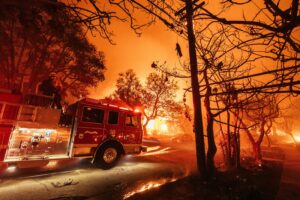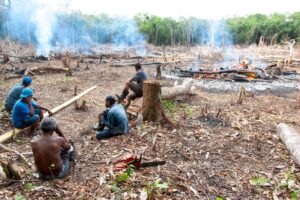This article will be updated throughout the day and an edited version will be sent out each evening as a newsletter – you can sign up here.
Is the end near for COPs in petrostates?
Fossil fuels have been given warm hospitality at COPs in recent years, with the last two climate summits being held in fossil fuel-expanding petrostates with presidencies even getting caught promoting oil and gas deals on the job.
That’s why a group of top climate experts, scientists and former UN chiefs called for reform in an open letter published this Friday, where they argue that countries expanding oil and gas should not be able to hold the COP presidencies.
Signed by former UN climate chief Christiana Figueres and former UN Secretary-General Ban Ki Moon, the letter calls on countries to establish a “strict eligibility criteria to exclude countries who do not support the phase out/transition away from fossil energy”.
The letter does not provide details of who would judge this criteria. Climate Home requested additional information, but had not received a response at the time of publication.
While the experts recognise the importance of UN climate talks, they also call for reform of the COP process, writing that the “current structure simply cannot deliver the change at exponential speed and scale” needed to address the climate crisis.
The COP29 presidency has been vocal about its disinterest in a quick fossil-fuel phase out, with Azerbaijan’s President Ilham Aliyev even telling the opening plenary that fossil fuels are a “gift from god” and that “we must be realistic” about energy transition.
An analysis of Aliyev’s speeches published today by campaign group 350.org found that the Azeri president defended or promoted fossil fuels in more than three quarters of his energy and climate-related speeches. In over a year of such speeches, Aliyev never even mentioned the Paris Agreement, the campaign group found.
Some campaigners backed the reform proposal. Catherine Abreu, director of the International Climate Politics Hub, said it is “demoralising” to hear the messages sent by Azerbaijan’s COP presidency.
She told media in Baku that the UN climate body, UNFCCC, should come up with a “conflict of interest policy” for delegates and the COP presidency that “puts a firewall between fossil fuel interests and the COP process.
She also called on countries to limit the influence of fossil fuel lobbyists at COP. According to another report published today by Global Witness, almost 1,800 lobbyists have shown up at COP29 – around 700 hundred less than last year but more than the 10 most climate-vulnerable countries combined.
Currently, countries can select who participates in their delegations, either with a “party” or “party overflow” badge. They do not choose people with an “observer” badge. Most lobbyists are observers, but some countries such as Japan, the UK, Canada and Italy brought fossil fuel lobbyists as part of their national delegations, the Global Witness report found.
According to the report, the biggest group of fossil fuel lobbyists is from an observer group called the International Emissions Trading Association (IETA) which sent 43 people.
But IETA denies this characterisation. While it does have a representative from French oil and gas giant TotalEnergies, an IETA spokesperson told Climate Home their delegates were “a broad mix” which “includes emitters who are committed to a just transition and solution providers who will help them on that journey”. Drawing up an exclusion list will be contentious.
Peace, Baku style
It is the “Energy, Peace Relief and Recovery” Day here in Baku. But if you’re running through the halls you won’t note much change – as there hasn’t been in conflict-afflicted nations across the world, despite Azerbaijan’s COP Truce proposal.
The COP29 host wanted to pause all the conflicts in the world – which number more than 50 – for the duration of the climate talks, inspired, they said, by the Olympic Truce.
On Friday, the COP Truce appeal did not feature prominently on the agenda. Nonetheless, the presidency said that the initiative received the support of 132 countries. That includes nations currently involved in civil wars and international conflicts, like Sudan, Myanmar, and the Democratic Republic of the Congo.
Azerbaijan itself has yet to reach a fully-fledged peace deal with neighbouring Armenia. According to Azeri media, Azerbaijan’s Foreign Ministry said that there cannot be any “physical meetings” with their Armenian counterparts until December as the climate summit is the government’s main focus.
When the COP Truce was first announced, climate campaigners called it a “performative… PR exercise” and “a distraction” from a separate UN-supported push to strengthen climate action in conflict-affected regions.
On that front, the COP29 presidency and six countries launched today the ‘Baku Call on Climate Action for Peace, Relief, and Recovery’, aiming to develop a strategy for preventing climate-induced wars and scaling up support for conflict-struck vulnerable nations.
The initiative will see the creation of a hub through which countries can “collaborate on peace and climate initiatives”.
During an event on this initiative, Climate Home asked Elshad Iskandarov, special envoy of Azerbaijan’s Ministry of Foreign Affairs, about the ceasefire appeal. He said that the truce was proposed to “foster peace in the world and highlight the importance of climate” without giving any further details.
But not everyone feels attuned to the “COP of peace” vision pushed by the COP presidency. Mohammed Usrof, founder of the Palestinian Youth Climate Negotiators Team, voiced concerns about COP29 being hosted in Azerbaijan because the country is Israel’s biggest crude oil supplier, as shown in a recent report by Oil Change International.
Mila Sirychenko, a Ukrainian activist, had reservations about expressing her views at COP due to the large size of the Russian delegation. Russia’s party at this COP counts 900 people, only topped by the Azeri (995) and Brazil delegations (984).
Chevron, ExxonMobil, BP, Shell and Eni – all companies that supply crude oil to Israel – brought a combined total of 39 lobbyists to the climate summit.
“So many others continue to be complicit with maintaining business as usual,” Usrof told Climate Home, referring to the almost 1,800 fossil fuel lobbyists at COP, many of whom are part of countries’ official delegations. “And, as we see, the business as usual involves the genocide of Gazans”.
“Puzzling” lack of pledges for adaptation
There’s a “great paradox” in evidence at COP29 between leaders’ speeches urgently calling to keep people safe from worsening climate change impacts – and the apparent lack of money available to do that, according to the head of the Adaptation Fund.
The UN fund – which has been at the cutting edge of efforts to build resilience to extreme weather and rising seas for the last two decades – only managed to secure contributions of around $61 million from donor countries at a fundraising event on Thursday, against its annual goal of $300 million.
This despite exhortations from UN Secretary-General Antonio Guterres and the UN climate chief at the start of COP29 for rich countries to fill the huge gap in adaptation funding, which could reach $187 billion-$359 billion a year by 2030.
“These missing dollars are not abstractions on a balance sheet: they are lives taken, harvests lost, and development denied,” said Guterres.
While there’s still time for more governments to come forward with new pledges before the end of COP29, Adaptation Fund head Mikko Ollikainen told Climate Home that “this year the situation looks quite difficult”.
“Contributor governments [are] almost all talking about the importance of adaptation – and quite a few of them are recognising the need for grant-based financing for adaptation especially – so it’s puzzling how that relates to the reality of there not being new pledges to the Adaptation Fund or adaptation funds in general,” he said on the sidelines of the COP.
At last year’s climate conference in Dubai, the fund also fell short of the same target – bringing in around $188 million. But there, wealthy governments had an excuse: they were also asked to dig deep to get the fledgling loss and damage fund up and running, which they did to the tune of nearly $700 million.
This year, however, they can’t hide behind the loss and damage fund as new money for that at COP29 has so far amounted to little more than Sweden’s $18.4 million pledge. Sweden has also stumped up around $763 million for the Green Climate Fund and $12 million for the Adaptation Fund.
This week the Adaptation Fund has received pledges from 10 European countries and regions, with flood-hit Spain offering the most ($19 million). The UK and the European Union are so far no-shows, though Germany has said it plans to contribute.
To make matters worse, the Least Developed Countries (LDC) Fund – also set up under the UN climate talks to help vulnerable countries adapt to climate change – has had to suspend a planned pledging event at CO29 after it “didn’t get very good signals” money would be forthcoming, the chair of the LDC Group told Climate Home on Friday.
Ollikainen said “the direction is quite wrong”, with needs going up and less money coming into the coffers of his fund. The Adaptation Fund has a long pipeline of projects but if donors don’t cough up more it will run out of money, he added. It is set to receive income from a 5% levy on sales of offsets in the new UN carbon market, but that may not start until 2026, he noted.
Samoan minister Cedric Schuster, who chairs the Alliance of Small Island States (AOSIS), told Climate Home he remains hopeful more money will come through for vulnerable countries at COP29 – and that the new climate finance goal due to be agreed in Baku will ensure contributions in the future.
“We can’t do anything if there are no pledges,” he said.
In brief…
Green light for new forest carbon credits: A key watchdog for the carbon market has given its high-integrity seal of approval to three methodologies for producing offsets that aim to reduce deforestation under so-called REDD+ projects. No credits have been issued so far under the rulebooks for forest projects approved by the Integrity Council for the Voluntary Carbon Market (ICVCM), but the body said “there is a large volume of credits in pipeline”. Hundreds of millions of existing REDD+ offsets have been issued under older methodologies but have faced widespread criticism over their alleged lack of real emissions reductions and failure to protect environmental and human rights. ICVCM did not assess the criteria for these earlier projects and producers of those credits will not be able to claim the high-integrity label unless they switch to the new methodologies.
The post COP29 Bulletin Day 5: Pressure to clean up COPs and shortfall in adaptation pledges appeared first on Climate Home News.
COP29 Bulletin Day 5: Pressure to clean up COPs and shortfall in adaptation pledges
Climate Change
UN report: Five charts showing how global deforestation is declining
The amount of forest lost around the world has reduced by millions of hectares each year in recent decades, but countries are still off track to meet “important” deforestation targets.
These are the findings of the Global Forest Resources Assessment – a major new report from the UN’s Food and Agriculture Organization – which says that an estimated 10.9m hectares (Mha) of land was deforested each year between 2015 and 2025.
This is almost 7Mha less than the amount of annual forest loss over 1990-2000.
Since 1990, the area of forest destroyed each year has halved in South America, although it still remains the region with the highest amount of deforestation.
Europe was the only region in the world where annual forest loss has increased since 1990.
Agriculture has historically been the leading cause of deforestation around the world, but the report notes that wildfires, climate change-fuelled extreme weather, insects and diseases increasingly pose a threat.
The Global Forest Resources Assessment is published every five years. The 2025 report compiles and analyses national forest data from almost every country in the world over 1990-2025.
Carbon Brief has picked out five key findings from the report around deforestation, carbon storage and the amount of forest held within protected areas around the world.
1. Rates of deforestation are declining around the world
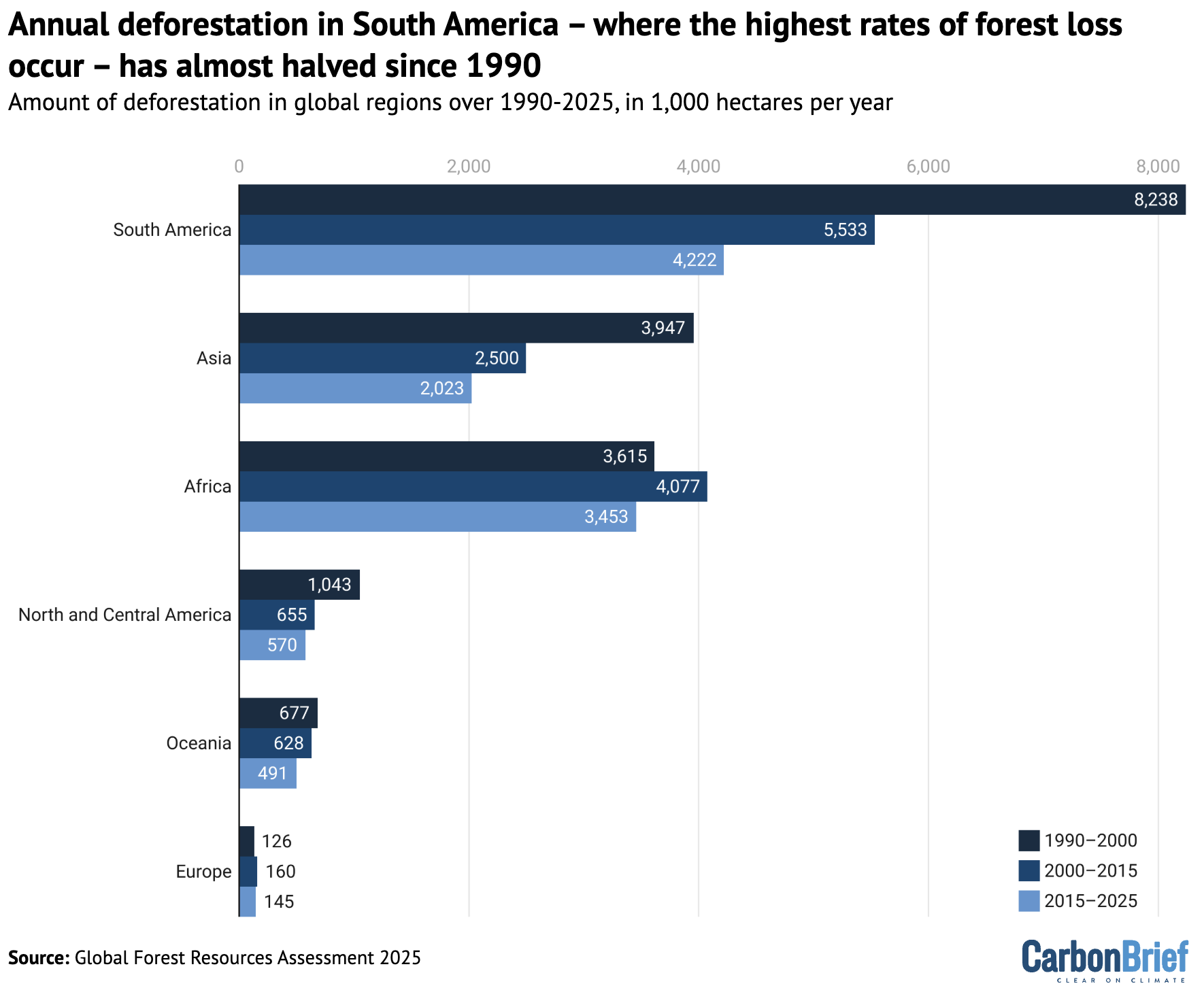
Rates of annual deforestation, in thousands of hectares, in South America, Asia, Africa, North and Central America, Oceania and Europe over 1990-2000 (dark blue), 2000-15 (medium blue) and 2015-25 (light blue). Source: Global Forest Resources Assessment 2025
In total, around 489Mha of forest have been lost due to deforestation since 1990, the new report finds. Most of this – 88% – occurred in the tropics.
This breaks down to around 10.9Mha of forest lost each year between 2015 and 2025, a reduction compared to 13.6Mha of loss over 2000-15 and 17.6Mha over 1990-2000.
Deforestation refers to the clearing of a forest, typically to repurpose the land for agriculture or use the trees for wood.
The chart above shows that South America experiences the most forest loss each year, although annual deforestation levels have halved from 8.2Mha over 1990-2000 to 4.2Mha over 2015-25.
Annual deforestation in Asia also saw a sizable reduction, from 3.9Mha over 1990-2000 to 2Mha over 2015-25, the report says.
Europe had the lowest overall deforestation rates, but was also the only region to record an increase over the last 35 years, with deforestation rates growing from 126,000 hectares over 1990-2000 to 145,000 hectares in the past 10 years.
Despite the downward global trend, FAO chief Dr Qu Dongyu notes in the report’s foreword that the “world is not on track to meet important global forest targets”.
In 2021, more than 100 countries pledged to halt and reverse global deforestation by 2030. But deforestation rates in 2024 were 63% higher than the trajectory needed to meet this 2030 target, according to a recent report from civil society groups.
The goals of this pledge were formally recognised in a key text at the COP28 climate summit in Dubai in 2023, which “emphasise[d]” that halting and reversing deforestation and forest degradation by 2030 would be key to meeting climate goals.
2. Global net forest loss has more than halved since 1990
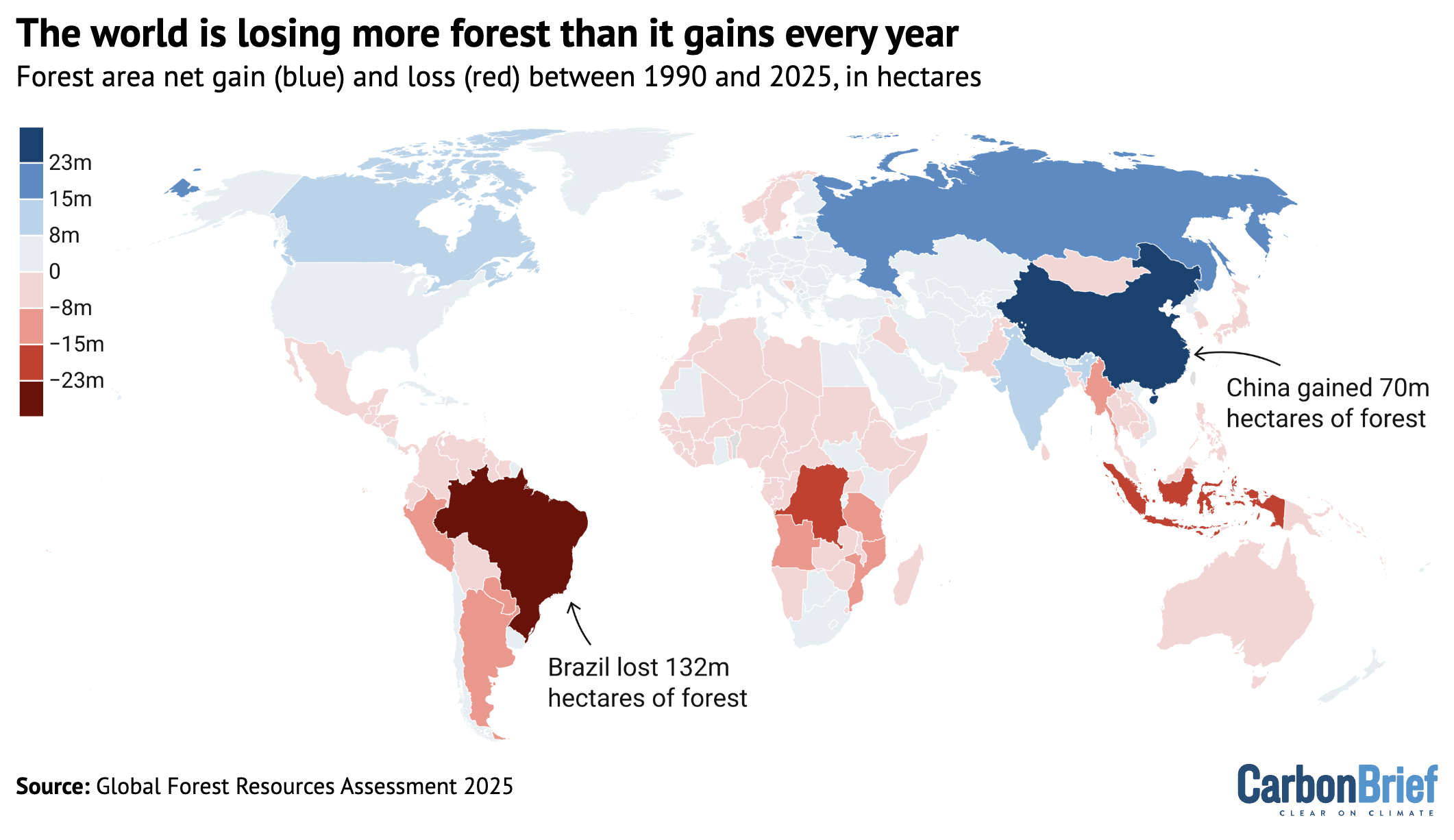
Forest area net change by country between 1990 and 2025, in hectares. Source: Global Forest Resources Assessment 2025
The new report finds that forests cover more than 4bn hectares of land, an area encompassing one-third of the planet’s land surface.
More than half of the world’s forested area is located in just five countries: Russia, Brazil, Canada, the US and China.
The map above shows that, overall, more forest is lost than gained each year around the world. There was 6.8Mha of forest growth over 2015-25, but 10.9Mha of forest lost.
The annual rate of this global net forest loss – the amount that deforestation has exceeded the amount regrown – has more than halved since 1990, dropping from 10.7Mha over 1990-2000 to 4.1Mha over 2015-25.
The report says this change was due to reduced deforestation in some countries and increased forest expansion in others. However, the rate of forest expansion has also slowed over time – from 9.9Mha per year in 2000-15 to 6.8Mha per year in 2015-25.
There are many driving factors behind continuing deforestation. Agriculture has historically been the leading cause of forest loss, but wildfire is increasingly posing a threat. Wildfires were the leading driver of tropical forest loss in 2024 for the first time on record, a Global Forest Watch report found earlier this year.
The new UN report says that an average of 261Mha of land was burned by fire each year over 2007-19. Around half of this area was forest. Around 80% of the forested land impacted by fires in 2019 was in the subtropics – areas located just outside tropical regions, such as parts of Argentina, the US and Australia.
The report notes that fire is widely used in land management practices, but uncontrolled fires can have “major negative impacts on people, ecosystems and climate”.
It adds that researchers gathered information on fires up as far as 2023, but chose to focus on 2007-19 due to a lack of more recent data for some countries.
A different report from an international team of scientists recently found that fires burned at least 370Mha of land – an area larger than India – between March 2024 and February 2025.
3. Many countries are hugely increasing their forest area
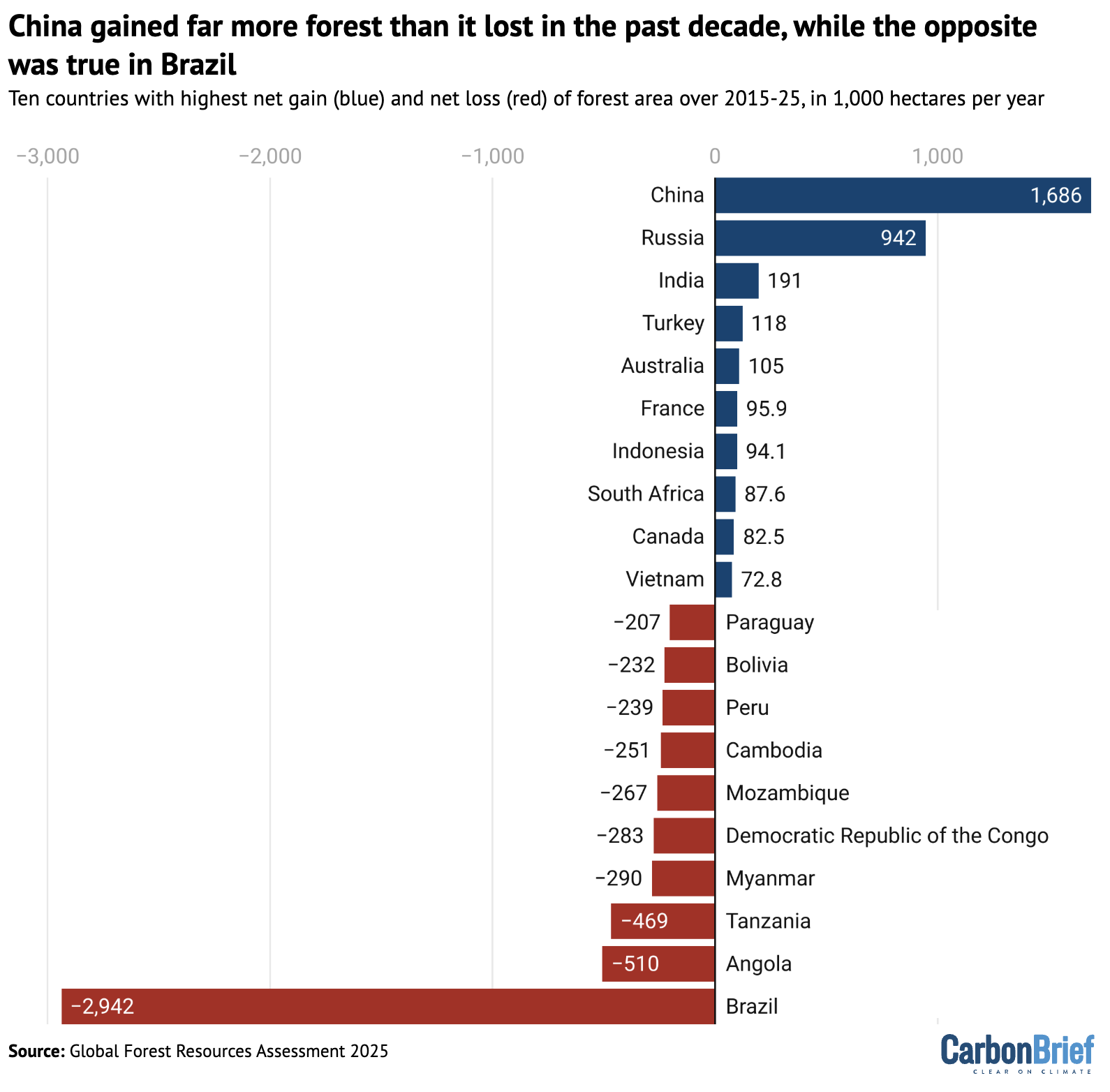
Top 10 countries for annual net gain (blue) and net loss (red) of forest area over 2015-25, in 1,000 hectares per year. Source: Global Forest Resources Assessment 2025
Globally, deforestation is declining, but the trend varies from country to country.
The chart above shows that some nations, such as China and Russia, added a lot more forest cover than they removed in the past decade through, for example, afforestation programmes.
But in other countries – particularly Brazil – the level of deforestation far surpasses the amount of forest re-grown.
Deforestation in Brazil dropped by almost one-third between 2023 and 2024, news outlet Brasil de Fato reported earlier this year, which was during the time Luiz Inácio Lula da Silva took over as president. The new UN report finds that, on average, Brazil lost 2.9Mha of forest area each year over 2015-25, compared to 5.8Mha over 1990-2000.
Russia’s net gain of forest cover increased significantly since 1990 – growing from 80,400ha per year in 1990-2000 to 942,000ha per year in 2015-25.
In China, although it is also planting significant levels of forest, the forest level gained has dropped over time, from 2.2Mha per year in 2000-15 to 1.7Mha per year in 2015-25.
Levels of net forest gain in Canada also fell from 513,000ha per year in 2000-15 to 82,500ha per year in 2015-25.
In the US, the net forest growth trend reversed over the past decade – from 437,000ha per year of gain in 2000-15 to a net forest loss of 120,000ha per year from 2015 to 2025.
Oceania reversed a previously negative trend to gain 140,000ha of forests per year in the past decade, the report says. This was mainly due to changes in Australia, where previous losses of tens of thousands of hectares each year turned into an annual net gain of 105,000ha each year by 2015-25.
4. The world’s forests hold more than 700bn tonnes of carbon
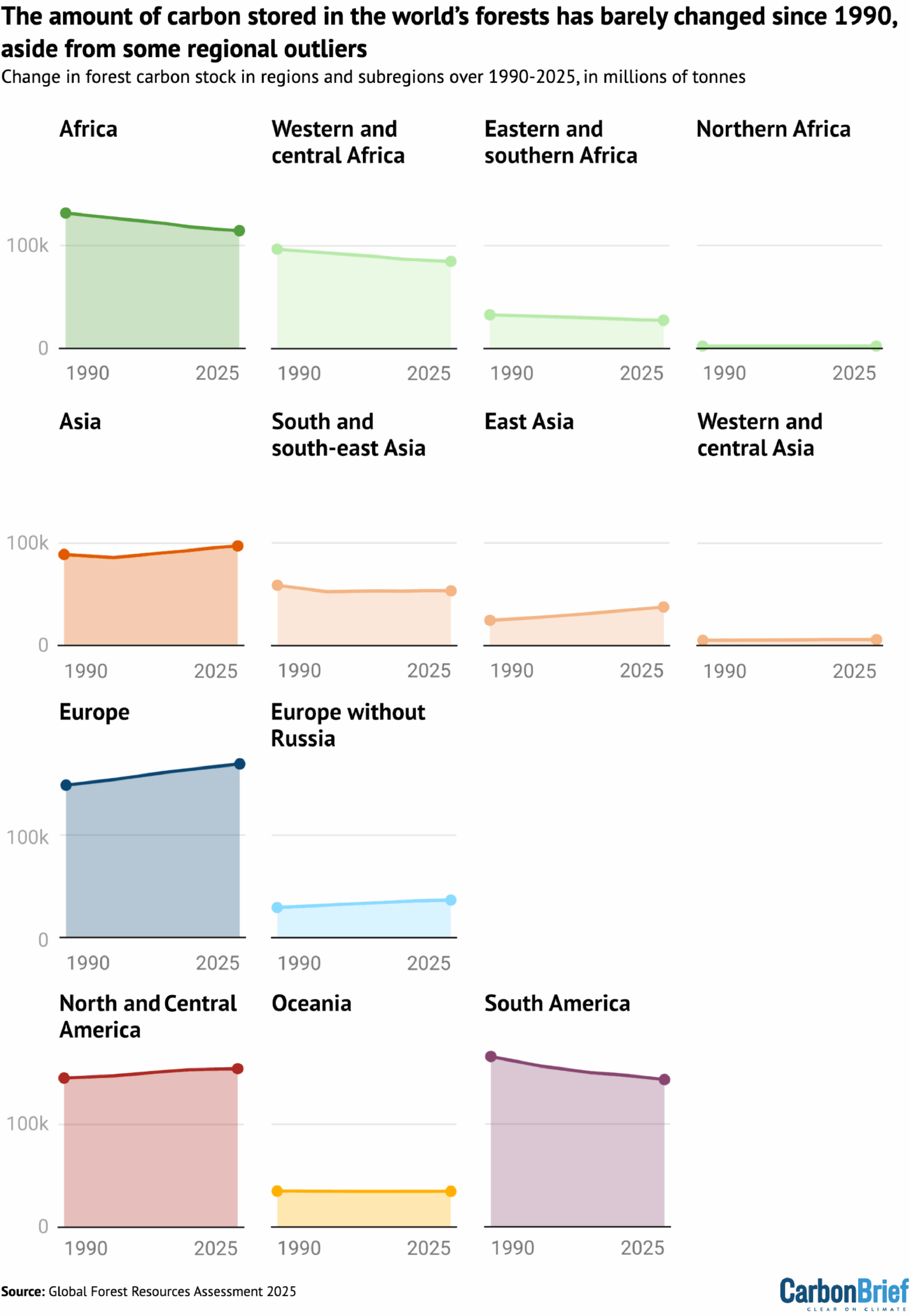
Changes in forest carbon stock by region and subregion of the world over 1990-2025. Source: Global Forest Resources Assessment 2025
The “carbon stock” of a forest refers to how much carbon is stored in its trees and soils. Forests are among the planet’s major carbon sinks.
The new report estimates that forests stored an estimated 714bn tonnes, or gigatonnes, of carbon (GtC) in 2025.
Europe (including Russia) and the Americas account for two-thirds of the world’s total forest carbon storage.
The global forest carbon stock decreased from 716GtC to 706GtC between 1990 and 2000, before growing slightly again by 2025. The report mainly attributes this recent increase to forest growth in Asia and Europe.
The report notes that the total amount of carbon stored in forests has remained largely static over the past 35 years, but with some regional differences, as highlighted in the chart above.
The amount of carbon stored in forests across east Asia, Europe and North America is “significantly higher” now due to expanded forest areas, but it is lower in South America, Africa and Central America.
Several studies have shown that there are limitations on the ability of forests to keep absorbing CO2, with difficulties posed by hotter, drier weather fuelled by climate change.
A 2024 study found that record heat in 2023 negatively impacted the ability of land and ocean sinks to absorb carbon – and that the global land sink was at its weakest since 2003.
Another study, published in 2022, said that drying and warming as a result of deforestation reduces the carbon storage ability of tropical forests, especially in the Congo basin and the Amazon rainforest.
5. Around one-fifth of the world’s forests are located in protected areas
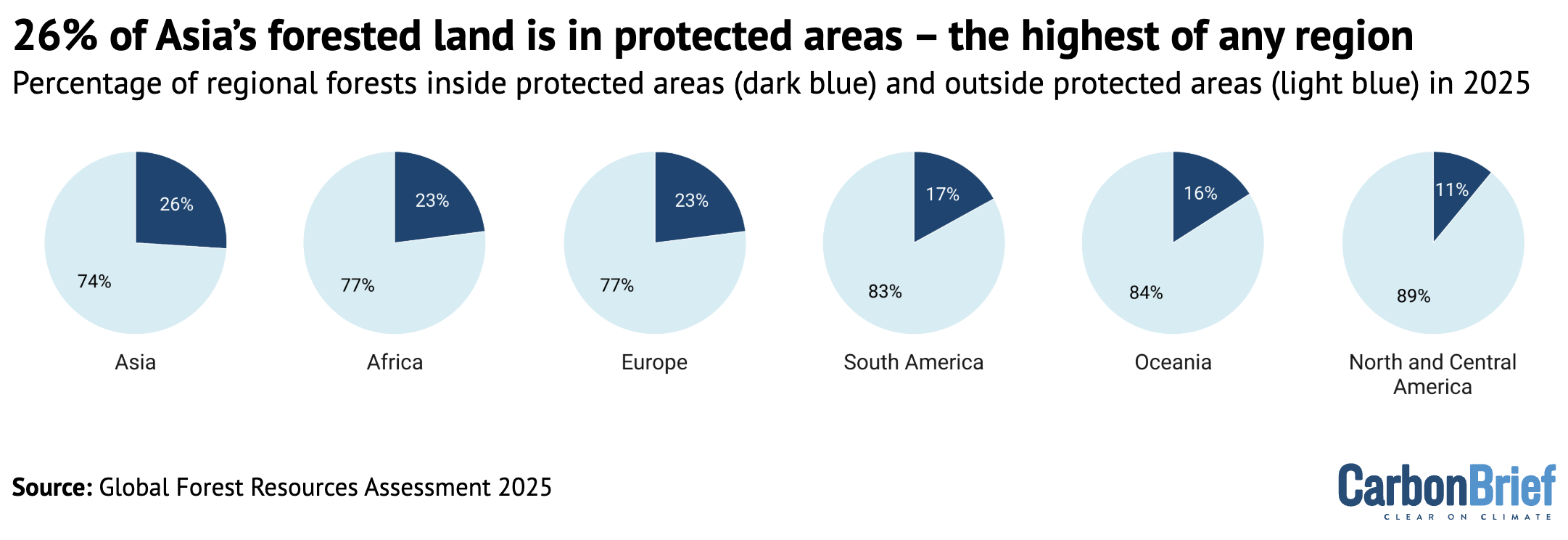
The percentage of forest land in Asia, Africa, Europe, South America, Oceania and North and Central America contained inside protected areas (dark blue) and outside protected areas (light blue) in 2025. Source: Global Forest Resources Assessment 2025
The amount of forested land located in protected areas increased across all regions between 1990 and 2025.
For an area to be considered “protected”, it must be managed in a way that conserves nature.
Around 20% of the world’s forests are located in these protected areas, the new report finds, which amounts to 813Mha of land – an area almost the size of Brazil.
Nearly every country in the world has pledged to protect 30% of the Earth’s land and sea by 2030. However, more than half of countries have not committed to this target on a national basis, Carbon Brief analysis showed earlier this year.
Almost 18% of land and around 8% of the ocean are currently in protected areas, a UN report found last year. The level is increasing, the report said, but considerable progress is still needed to reach the 2030 goal.
The new UN report notes that Europe, including Russia, holds 235Mha of protected forest area, which is the largest of any region and accounts for 23% of the continent’s total forested land.
As highlighted in the chart above, 26% of all forests in Asia are protected, which is the highest of any region. The report notes that this is largely due to a vast amount of protected forested land in Indonesia.
Three countries and one island territory reported that upwards of 90% of their forests are protected – Norfolk Island, Saudi Arabia, Cook Islands and Uzbekistan.
The post UN report: Five charts showing how global deforestation is declining appeared first on Carbon Brief.
UN report: Five charts showing how global deforestation is declining
Climate Change
Federal Appeals Court Pauses Litigation Over Florida’s Alligator Alcatraz
The Trump administration had sought the stay of proceedings in the case, arguing its attorneys were furloughed during the government shutdown. The plaintiffs say the administration is picking and choosing which cases to litigate.
A federal appeals court paused litigation Wednesday brought by environmental groups over Florida’s Alligator Alcatraz, the hastily assembled Everglades detention site where the Trump administration aims to incarcerate and deport thousands of undocumented migrants.
Federal Appeals Court Pauses Litigation Over Florida’s Alligator Alcatraz
Climate Change
Breach of Contract or Constitutional Crisis?
An appellate court will determine how to handle the Trump administration’s cancellation of hundreds of climate and environmental justice grants.
The U.S. Fourth Circuit Court of Appeals in Richmond, Virginia, heard arguments Thursday on whether the Trump administration’s cancellation of billions of dollars in environmental and climate grants earlier this year violated the Constitution or was merely a contract dispute.
-
Climate Change2 years ago
Spanish-language misinformation on renewable energy spreads online, report shows
-
Climate Change2 months ago
Guest post: Why China is still building new coal – and when it might stop
-
Climate Change Videos2 years ago
The toxic gas flares fuelling Nigeria’s climate change – BBC News
-

 Greenhouse Gases1 year ago
Greenhouse Gases1 year ago嘉宾来稿:满足中国增长的用电需求 光伏加储能“比新建煤电更实惠”
-
Greenhouse Gases2 months ago
Guest post: Why China is still building new coal – and when it might stop
-

 Climate Change1 year ago
Climate Change1 year ago嘉宾来稿:满足中国增长的用电需求 光伏加储能“比新建煤电更实惠”
-

 Carbon Footprint2 years ago
Carbon Footprint2 years agoUS SEC’s Climate Disclosure Rules Spur Renewed Interest in Carbon Credits
-
Renewable Energy3 months ago
US Grid Strain, Possible Allete Sale

